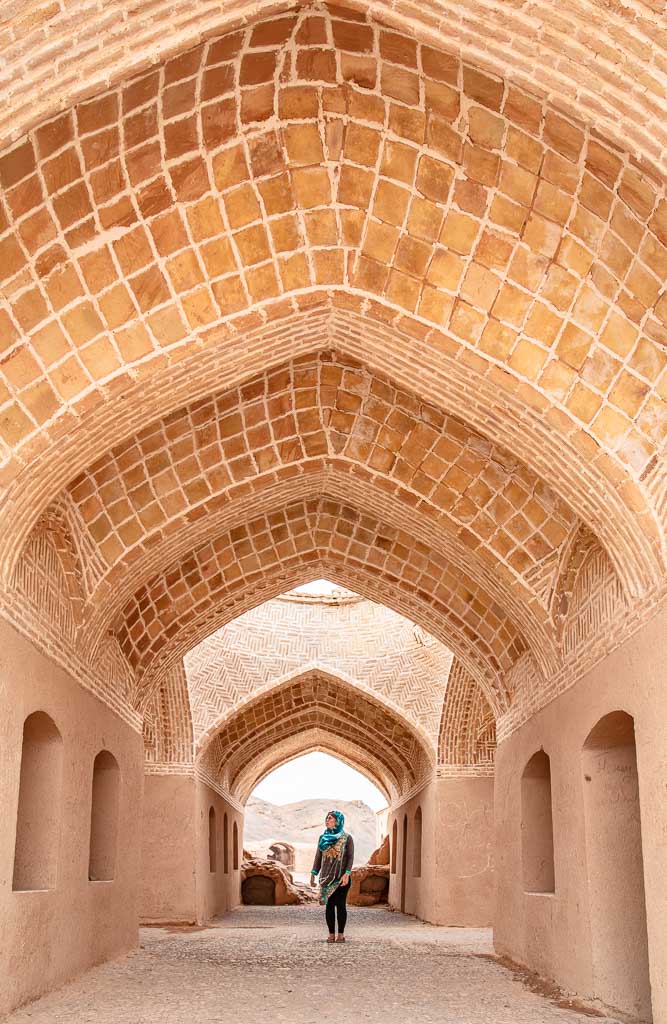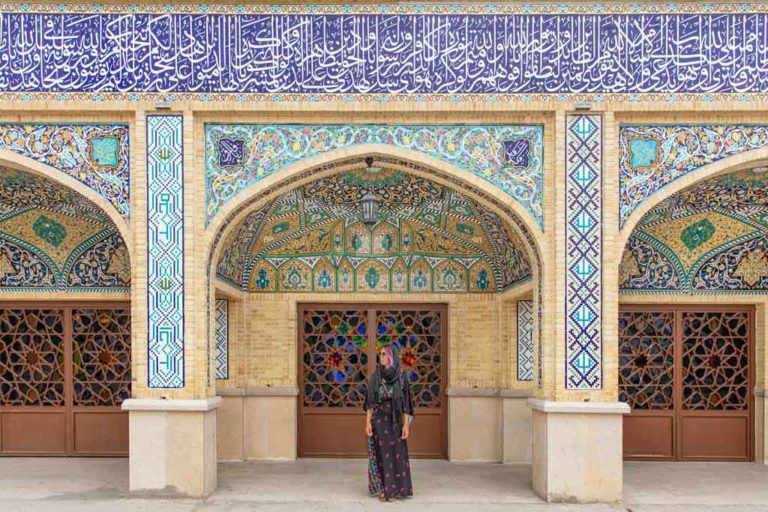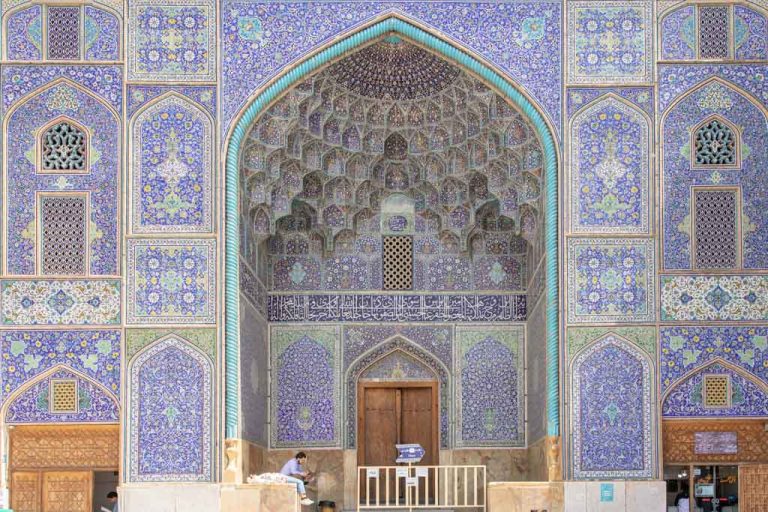
Solo Female Travel in Iran
Updated June 2023, Solo Female Travel in Iran was originally written in May 2019
Yes- it’s possible, no- it’s not inherently dangerous. You might have to deal with a few inconveniences, annoyances and a challenge hither and tither but overall solo female travel in Iran is a rewarding experience.
I spent a couple of days shy of an entire month backpacking solo overland across Iran from Afghanistan to Iraqi Kurdistan in April 2019. This trip brought me to Mashhad, Kerman, the Kaluts Desert, Bandar Abbas, Hormuz Island, Shiraz, Persepolis, Yazd, Esfahan, Kashan, Tehran, Tabriz, and Kandovan. So from my experience, here are my best tips and trips for women traveling solo in Iran.
Start planning with my Iran itinerary for independent travelers

What To Wear
What to wear in Iran is probably the first thing that crosses any female traveler’s mind when planning a trip to Iran. Yes, Iran is conservative– but not as much as you’re likely thinking. Dressing in hijab, a term for modest Islamic dress is mandatory, though tourists seem to be cut a bit of slack on this compared to locals.
Here are a few ground rules for how you should dress:
- Headscarves must be worn at all times when out in public
- Longsleeves must be worn when in public, 3/4 sleeves are generally fine
- Your top should at least cover your bum. Long tunics, manteau, shalwar kameez, and long dresses are your best choices
- Legs should be covered to the ankle, leggings and skinny jeans are common
As long as you abide by the aforementioned list on dress code it will be smooth sailing for women travelers in Iran. If you are worried about your headscarf falling off you can purchase pins that help hold them in place. If your headscarf does fall off someone will likely tell you.
If you really want to blend in with the locals I suggest purchasing a manteau (a long usually knee-length jacket) from a bazaar when you arrive, typically one will set you back about $20 USD.
Other things worth mentioning on female dress code:
- Chador (the all-enveloping black cloak) are required to be worn by women entering certain mosques and shrines in Iran. In general, the places that require them will have them on loan either at the women’s entrance or at a separate counter, either way, if they are required you will be directed towards them.
Transportation
I’m all for equality and all… but can I say that I actually loved riding in the ‘women only’ sections on the public city buses and metros? Yes, in Iran some forms of transport will have women-only sections. Other forms of transport that do not have this typically try to arrange you in a way that you wouldn’t sit next to an unfamiliar man. Here’s a quick breakdown of the transport forms:
Public City Buses
- Women only are allowed in the back of the bus, men must sit in the front
- If you are a woman traveling with a man (husband, boyfriend, friend, etc.) you can sit in front with their male counterpart
Long Distance Buses Between Cities
- Most long-distance buses have a seating arrangement of 2 & 1, meaning that the passenger side of the bus has double seats and the driver side will have single seats. Typically solo women will be sat in single seats, or at least you’ll be asked which you want.
- You can either go to the bus stations (I’d recommend in advance for high season) or search and book online at 1st Quest.
Shop for bus tickets at 1st Quest
Metro/Subway
- Metros will have a couple ‘women only’ cars at one end of the train. You don’t have to go to the women’s only section, but it’s an option. If you are traveling with a male he will not be allowed in the women’s section (unless of course, he’s a child).
Taxis
- There’s no gender separation when it comes to taxis, however, it is generally recommended to sit in the back seat.
- Many times if you hop in a taxi on the street the driver will ask, dar baste? Dar baste translates to ‘open door‘ in Farsi. They are asking if you’d like to pick up others on the way to your destination and split the cost. If you don’t mind sharing a taxi say, baleh or areh (yes or yeah), if you do not want to share just say, nah dar baste (no open door).
Savari
- Savaries are shared taxis that zip between cities and are typically a bit quicker than traveling by bus.
- Most women will request the front seat (which typically will cost a few tomans more) to avoid the usual grope that will happen on shared transport.

Accommodation
Accommodation is pretty straightforward and for the most part like anywhere else, you’d travel. Hostels are becoming increasingly common and guesthouses can be found just about anywhere in Iran.
Note that major booking sites like booking.com do not operate in Iran. The best and most varieties of accommodations can be found via 1st Quest. I found that in more popular cities I could book using hostelworld.com.
The easiest way of booking most places I stayed I found to be via phone call (locals SIM cards are cheap and easy to get), or by texting accommodations on WhatsApp and Telegram. Here is a list of accommodations I stayed in all the places I visited:
- Mashhad: Vali’s Homestay
- Kerman: Keykhosro Guesthouse (email: [email protected] | phone: +98 34 3312 7264)
- Bandar Abbas: Darya Hotel +98 76 3224 1941
- Hormuz: A family guesthouse via my friend Mohamed +98 99 0499 6642
- Shiraz: Stayed with friends
- Yazd: Backpack Hostel +98 91 3520 5100
- Esfahan: Amir Kabir Hostel +98 31 3222 7273
- Kashan: Shirin Hostel
- Tehran: Tehran Heritage Hostel
- Tabriz: Darya Guesthouse +98 91 4615 7444
Shop hotels and more at 1st Quest

Solo Female Travel In Iran Safety & Tips
The sight of a woman traveling alone is a bit unusual in Iran, so plan to get attention for this– meaning both positive (most of the time) and negative (seldom, but still happens). Most Iranian women travel with their fathers, husbands, or brothers, in fact, several Iranian women I met were surprised that my husband let me travel without him.
Many times Iranian men’s exposure to western women has come in the form of movies and to be totally honest- porn (Iranian friends are who told me this). Overall my dealings with Iranian men were overwhelmingly positive, but there’s always going to be a few less than pleasant encounters. Note that foreign travelers aren’t the only ones who receive this attention, it happens to Iranian women too. Here are a few examples from my experience:
- I’m walking down a narrow alleyway in Yazd, a young man rides past me on a motorcycle and said ‘hello’, I said ‘hello’ back and continued walking. He turned around on his bike and drove by again and asked: “do you want the sex?” I said no and kept walking.
- Man working at a mosque in Esfahan insists I have a cup of chai and I finally say yes. He pours the tea and then points to himself and me and to a door. I looked at the door and looked at him (and probably with a hint of confusion). He again points to him, to me, the door, and then makes a ring with his fingers on his left hand and sticks his right index finger through the ring. Okay, we’re done here. And did you seriously just ask me for sex at a mosque you filthy f***ing animal?
- In the middle of Naqsh e Jahan Square in Esfahan in broad daylight, a younger guy walks up and asks to take a selfie with me. I said okay, and before I knew it he had reached his arm around me and grabbed my boob. I slapped the shit outta him and then the angry mob of Iranians came over to set him straight. Lesson: if a man does anything to you, make a scene.
- I’m walking down a street in Tehran near the Grand Bazaar and Golestan Palace looking for a restaurant to grab a quick dinner. A man on a motorbike with his friend riding on the back holding a crutch and in a leg brace slowly drives by (I don’t look at the man driving, but I know he’s staring at me). He then speeds off, then turns around further ahead, and drives by me slowly again. He does this two more times before he puts his temporarily crippled friend on the side of the road and then chases me down on foot to invite me to eat. I could tell this wasn’t a gesture of warm Iranian Taarof (taarof is the system of politeness that you will definitely experience in Iran) but an invitation of a foreign woman to his house. He followed me for quite a while and I kept walking faster and faster. He eventually tried to touch my arms and I slapped his hand away. At that point, he finally gave up.
So as you can see only one time was I actually touched inappropriately and out of an entire month spent traveling around Iran only 4 incidents really stuck in my memory. In general, Iran is pretty safe in this regard but you’ll likely have a few unpleasant encounters.
Here are a few ground rules to help prevent issues for solo female travelers in Iran:
- Don’t offer to shake hands with men you don’t know, place your hand over your chest when greeting
- Don’t be too overly friendly with strange men, many times it can be received the wrong way. In many cases friendly=sexually interested
- If a man invites you somewhere verify that his wife/sister/mother/another woman will be there. It’s not exactly appropriate to be alone somewhere with an unfamiliar man
- Even if you do all of the above, some men are still perverts, so you’ve been warned (this isn’t limited to Iran, I’m talking about everywhere)

General Iran Travel Tips
- Learn some basic phrases in Farsi, and learn to read Persian numbers before you arrive. I found that no matter where I traveled in the country there was always someone around that spoke some English so communicating wasn’t very challenging, even for tourists I met that didn’t know a word of Farsi.
Hello: salaam
Yes: baleh/areh
Thank you: merci/motoshakarem/khaley momnoon
How are you?: khoobastee?/Hale toon chetor e
Good: khoob
Please to meet you: Khosh vactam
You’re welcome: Khokhesh mekonam
How much does it cost?: Gheymatish chand e?
0: ۰ (sefr)
1: ۱ (yak)
2: ۲ (du)
3: ۳ (se)
4: ۴ (chahar)
5: ۵ (panj)
6: ۶ (sheesh)
7: ۷ (haft)
8: ۸ (hasht)
9: ۹ (nu)
10: ۱۰ (dah)
Note that with numerals that sometimes Arabic numbers are used (4, 5, and 6 are the only numbers that differ), meaning 4 is ٤, 5 is ٥, and six is ٦. - Taarof that I mentioned earlier is hardwired into Iranian culture. Many times people will refuse payment as part of taarof, like taxi drivers, hotel receptions, shopkeepers, etc. but do always pay even though you may have to insist a couple of times. Another aspect of taarof is invitations to stay in homes, meals, and more. The unspoken rule is to kindly refuse 3 times and if the offer still stands it’s not just taarof, they actually are truly inviting you.
- There’s no way of withdrawing money with foreign cards in Iran. There is also no Western Union or anything like that. Bring enough cash with you for your trip. There is however something called a Mah Card which you can order prior to your trip and load money onto online from a bank account.
- Money is rather confusing in Iran. Officially the currency of Iran is the Iranian Rial or IRR. Iranian currency has been fluctuating wildly the last few years and has inflated massively so Iranians don’t typically give prices in Rials but rather Tomans. Tomans are equal to 10 rials, so the easiest way of explaining this is to say just to knock off a zero from the price in rial (10,000 tomans is 100,000 rials). As of March 2020, the exchange rate (black market rate) was $1 USD=149,000 IRR and (bank rate) was $1 USD=42,100 IRR but in 6 hours this rate could be very different.
- There are two exchange rates in Iran, bank rate and black market rate. Obviously, the black market rate is much better (during my visit bank rate was about 42,000 IRR to $1 USD and the street was 130,000-138,000 IRR to $1 USD). Blackmarket rates are traded in exchange shops in cities and towns. If you’re unsure ask locals to point you to a reputable one. Check out current rates here.
- American, British and Canadian passport holders cannot travel independently in Iran (sorry, I don’t make the rules). All three nationalities must go on a guided tour with a government-approved tour guide in order to get a visa authorization code. You will need to apply for your visa in advance using the authorization code.
- Passport holders from Armenia, Azerbaijan, Bolivia, Egypt, Georgia, Lebanon, Malaysia, Oman, Syria, Turkey, and Venezuela do not require a visa to enter Iran.
- Most other nationalities are eligible for a visa on arrival if arriving by air to Iran, though they will need to provide proof of travel insurance eligible in Iran or purchase it on the spot.
- If you plan to enter Iran at any of the land borders you must apply for a visa in advance (aside from the above mentioned visa-free passport holders). Apply for your Iranian visa authorization code here, you will need this in order to apply for your actual visa.
- Spring and fall are the best times to visit Iran. June-August are brutally hot, and winter can get quite cold.
- Getting a SIM card is cheap and easy. I paid about 1,000,000 IRR for an Irancell SIM and 10gb data for a month.
- Some websites and social medias are blocked in Iran (Facebook, Twitter, etc. are blocked but ironically Instagram is not), to get around this you’ll need to download a VPN.
- I recommend getting a copy of the Bradt Iran guidebook to help you plan.

Need Travel Insurance For Iran?
Start shopping plans over at 1st Quest.

























I am enjoying very much your blog full of adventures. I had mines also.
When you say “American passport holders cannot travel independently in Iran” you mean USA passport holders, because of many other Americans (Mexican, Argentinian, Peruvian, Chilean, Brazilian, etc.., yes the can.
In the other hand, I have been travelling solo thru Iran twice and it is one of my preferred countries because of his people. You can see my photos in:
https://www.flickr.com/photos/[email protected]/albums
Look for the Iran North &West and Iran albums
Yeah sorry, had the whole “ABC” thing in my head referring to American (US), British (UK) and Canadian. I guess I’ll just refer to them as United Statsians now on, since it’s so offensive for people from the US to be referred to as American